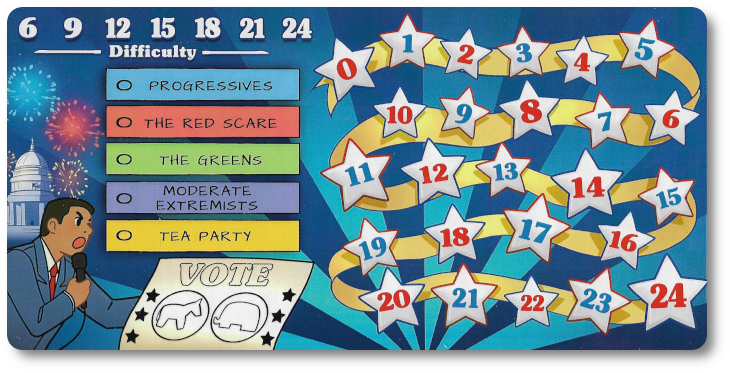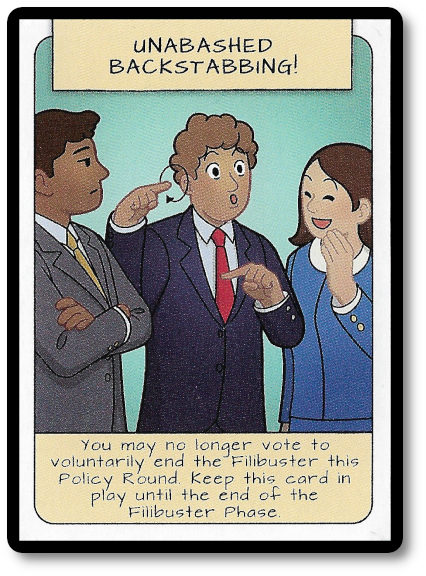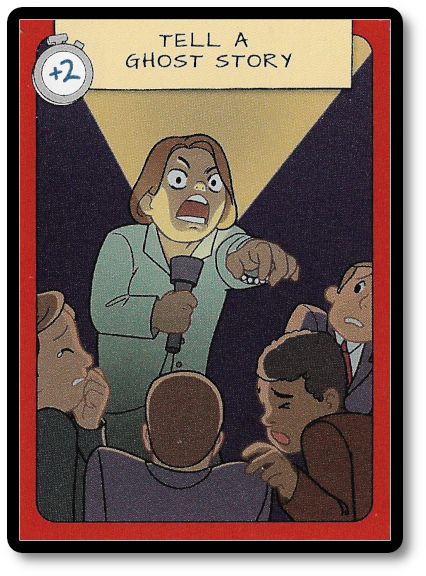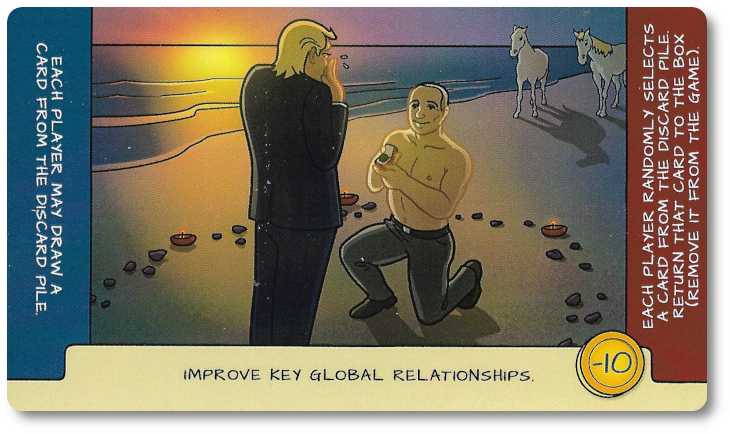Please Take Note: This is a review of the final game, but it might change slightly based on the success of the Kickstarter campaign. The game is being reviewed on the components and the rules provided with the understanding that “what you see is not what you might get” when the game is published. If you like what you read and want to learn more, we encourage you to visit the Kickstarter campaign. Now that we have all that disclaimer junk out of the way, on with the review.

The Basics:
- For ages 10 and up
- For 3 to 5 players
- Approximately 45 minutes to complete
Geek Skills:
- Active Listening & Communication
- Counting & Math
- Logical & Critical Decision Making
- Reading
- Strategy & Tactics
- Cooperative & Team Play
- Hand/Resource Management
- Bluffing and Misdirection
- Auctioning, Bidding, & Trading
Learning Curve:
- Child – Easy
- Adult – Easy
Theme & Narrative:
- Wheel, deal, and kill
Endorsements:
- Gamer Geek approved!
- Parent Geek approved!
- Child Geek mixed!
Overview
American author, politician, U.S. Ambassador and public conservative figure, Clare Boothe Luce, said “They say women talk too much. If you have worked in Congress you know that the filibuster was invented by men.” As a political tool, a filibuster can best be thought of as a blunt instrument, at best. Its single goal is to talk a political debate to death. In this game, there is a lot of killing…of political policies.
Filibuster, designed by Dan Kramer (II) and to be published by Biplane Games, will reportedly be comprised of one small game board, 20 Policy cards, five Player Reference cards, 24 Time cards, 58 Action cards, one sand timer, and an assortment of tokens to track voting, influence, player turns, and filibustering. As this is a review of a prepublished game, I cannot comment on the game component quality. The artwork by Fernando Olmedo and Juliana Ouyang is very clean, stylized, and professional.
We Will Now Come To Order…
To set up the game, first take the Policy deck, shuffle, and deal seven face-down in the middle of the playing area. Create two rows, with the first row containing four Policy cards and the second row containing three Policy cards. Place any remaining Policy cards back in the game box.
Second, take the Action deck, shuffle, and deal four cards to each player, face-down. This is the player’s starting hand. Place the Action card deck next to the Policy cards.
Third, place the game board next to the Policy cards and Action deck. Give to each player at this time two Influence tokens for a total value of “two” (these are used like currency in the game). Place the remaining tokens into pools next to already placed game components.

Fourth, take the Time deck, shuffle, and place face-down next to the game board.
Fifth, flip the top-left Policy card in the first row face-up, indicating it’s the first policy being proposed and in play.
That’s it for game set up. Determine who will be the first player (known as the “Senate Minority Leader”) and begin.
The Chair Recognizes the Player
Filibuster is a semi-cooperative game played in rounds for no more than a total of seven rounds per game. A game round is summarized here.
Phase One: Filibuster
If the Time deck has not been shuffled since the last round, it’s shuffled now. The Time cards represent the amount of time (not real-time) the player’s have to successfully block a policy. Time cards will either harm, help, or do nothing to the player’s goals to kill the policy via a filibuster. If the Time card has rules listed on it, they take effect until the next Time card played replaces it.

The starting difficulty is six hours. Each successful policy that is filibustered adds an additional three hours to the minimum time needed to filibuster an active policy. If a previous policy was unsuccessfully filibustered, the minimum time remains the same as the last round. The maximum level of difficulty in the game is 24 hours. The difficulty can be tracked by using the Difficulty track on the game board.
The current Senate Minority Leader now plays a card from the Time deck, flipping it over and placing it face-up for all the players to see. I find reading it out loud helps ensure all the players have an opportunity to ask any questions before the action begins.
The Senate Minority Leader must now play a red-bordered Action card from their hand (if possible), which increases the amount of time by one to six hours to the current filibuster round length as long as it’s not ended by the Time deck. If the Senate Minority Leader does not have a red-bordered card or a card with the keyword “Assist”, no card is played. Instead, they can (if they like) play one Influence to advance the Filibuster track by one hour. Note that the Filibuster track is NOT the same as the Difficulty track. The Filibuster track is used to mark the progress of each Filibuster attempt of the active policy for the round.

The next player in turn order sequence now goes (normally the player who has the Player Turn token). Each remaining player, referred to as “Minority Senators”, draw one card from the Action deck and may take one of the following actions, and once complete, pass the Player Turn token to the player on their left:
- Draw one additional Action card, adding it to their hand
- Play a blue-bordered Action card with the “Assist” keyword (as long as the card played does not increase the length of the filibuster)
- Pass a red-bordered Action card to the Senate Minority Leader
When playing a card, the Minority Senator must pay for it using Influence. The amount of Influence the card costs is indicated on the card’s face. If the player can pay for the card, they do so, play it, and resolve it, following the instructions on the Action card.

If the player elects to pass a card to the Senate Minority Leader, they are awarded an amount of Influence equal to the time noted on the Action card.
But before the next Minority Senator takes their turn, play returns to the Senate Minority Leader, who is on the floor attempting to filibuster the current policy in play. This continues until the current filibuster ends, which can happen one of three ways.
- If a card drawn from the Time deck ends the round
- The Time deck is empty on the Senate Minority Leader’s turn
- The players have successfully managed a 24 hour filibuster
These are the only three conditions that end a round, even if the players have met the minimum time needed for the filibuster.
Of course, the players can also vote to end the filibuster. This is done by the Senate Minority Leader, on their turn, announcing a vote. This is done via discussion first, with players giving their thoughts on the tactical importance of voting or not at this time. Each player is given 30 seconds (use the sand time) to pitch their idea, for or against the vote. Then all players take a voting token, determine which side to show (“Aye” or “Nay”), hide it, and then reveal when all players are ready. If all players vote “Aye”, the filibuster ends successfully, but all players forfeit their right to claim reward (noted on the Policy card) and the current Senate Minority Leader only earns half of the Influence.
But wait! There’s more!
Before the players vote, opponents can attempt to “buy their vote”, using cards and Influence tokens. This is meant as a bargaining method, not a manipulation tool (although we all know how that works).
If the “Nay’s” have the vote, each player who voted “Nay” gains an amount of Influence equal to the Policy round. Play then continues as normal with the policy still in dispute.
Phase Two: Snap Election
The policy has either been successfully blocked or not, indicating the round is coming to a close, but before it does, it’s time to vote for a new leader.

To begin, make sure each player has, at minimum, four Action cards in their hand. Then reveal the next Policy card in the row. Immediately flip over the sand timer, giving everyone 30 seconds to discuss who should be the new Senate Minority Leader.
Players vote for the new leader of the next round by placing their Voting token onto the corresponding colored player space found on the game board. All votes are public, meaning everyone sees who the other is voting for. As usual, cards and Influence tokens can be exchange for political favors. Once the sand timer runs out, voting ends and the Voting tokens can no longer be moved.
If the voting requirements for the new Senate Minority Leader are not met (determined by the number of players in the game), the party has failed to unify. The current Senate Minority Leader retains their position and all other players must discard the cards in their hand. The Senate Minority Leader must pay an Influence penalty equal to the amount shown on the newly revealed Policy card.
This ends the round. A new round now begins.
Order! We Will Have Order!
The players win the game if they successfully filibuster four out of the seven Policy cards. This means the game could end in four rounds or last all seven. If the players do not successfully filibuster enough Policy cards, they all lose. If they do block the needed number of Policy cards, the winner of the game is the player who has the most Influence.
To learn more about Filibuster, visit the Kickstarter campaign.
Final Word
 The Child Geeks understood the game, but never really got into it. According to one Child Geek, “I don’t know why you wouldn’t want to always work together to win.” Ah, children. So young. So innocent. In Filibuster, you must work together, but only to a point. This is what makes the game fun and challenging. If this is not understood, yes, the game seems really straight forward and, I would argue, unimpressive. Working together to “beat the clock” isn’t that hard if everyone is on the same page. Which players are, sort of, in Filibuster. As one Child Geek put it, “If you play the game right, you don’t want anything to go wrong but you really don’t want everything to go right either. It was a bit confusing and hard to play the game win.” Very true! The difficulty in Filibuster is the balance one must attempt between outright support and selfish gains. The Child Geeks never latched onto this, and as such, the game fell a bit flat. Regardless, they all enjoyed it, but not to the extent as our other groups, as you will now read.
The Child Geeks understood the game, but never really got into it. According to one Child Geek, “I don’t know why you wouldn’t want to always work together to win.” Ah, children. So young. So innocent. In Filibuster, you must work together, but only to a point. This is what makes the game fun and challenging. If this is not understood, yes, the game seems really straight forward and, I would argue, unimpressive. Working together to “beat the clock” isn’t that hard if everyone is on the same page. Which players are, sort of, in Filibuster. As one Child Geek put it, “If you play the game right, you don’t want anything to go wrong but you really don’t want everything to go right either. It was a bit confusing and hard to play the game win.” Very true! The difficulty in Filibuster is the balance one must attempt between outright support and selfish gains. The Child Geeks never latched onto this, and as such, the game fell a bit flat. Regardless, they all enjoyed it, but not to the extent as our other groups, as you will now read.
 The Parent Geeks, who are all kinds of fed up with politics in this country (see our review of President Bigly for some cringy commentary), found Filibuster to be “a light version of what makes politics fun”. Which is to say, they completely politically exhausted Parent Geeks, who feel they are awash in political negativity, saw Filibuster as anything but. According to one Parent Geek, “This is how you make a game about politics. You don’t make it about real politics. You make it about stuff you can roll your eyes at without feeling you need to defend any real world position.” Another Parent Geek said, “This game was insightful. It gave me a better understanding of how broke our political system is and how easy it is to manipulate – or attempt to – the vote. Not happy about that, but I’m happy with this game.” When all the votes were in (pun intended) Filibuster passed.
The Parent Geeks, who are all kinds of fed up with politics in this country (see our review of President Bigly for some cringy commentary), found Filibuster to be “a light version of what makes politics fun”. Which is to say, they completely politically exhausted Parent Geeks, who feel they are awash in political negativity, saw Filibuster as anything but. According to one Parent Geek, “This is how you make a game about politics. You don’t make it about real politics. You make it about stuff you can roll your eyes at without feeling you need to defend any real world position.” Another Parent Geek said, “This game was insightful. It gave me a better understanding of how broke our political system is and how easy it is to manipulate – or attempt to – the vote. Not happy about that, but I’m happy with this game.” When all the votes were in (pun intended) Filibuster passed.
 The Gamer Geeks are always on the lookout for a new semi-cooperative game. They like to play to win and winning as a group is not as attractive as using the group to win. In Filibuster, they found a good mix of cooperation and manipulation, allowing them to work the game (and the players) to a point where they felt satisfied. According to one Gamer Geek, “A good game with just enough chaos to keep things in disorder and more than enough opportunities to begin to put it back in a place where you feel like you have control again.” Another Gamer Geek said, “In this game, it’s all about meeting the objective of helping others whilst helping yourself. It’s a one-for-you and two-for-me kind of scenario, where everyone is looking to help, but you need to get back something in return. I liked it.” The Gamer Geeks all agreed that Filibuster was worth their time at the gaming table.
The Gamer Geeks are always on the lookout for a new semi-cooperative game. They like to play to win and winning as a group is not as attractive as using the group to win. In Filibuster, they found a good mix of cooperation and manipulation, allowing them to work the game (and the players) to a point where they felt satisfied. According to one Gamer Geek, “A good game with just enough chaos to keep things in disorder and more than enough opportunities to begin to put it back in a place where you feel like you have control again.” Another Gamer Geek said, “In this game, it’s all about meeting the objective of helping others whilst helping yourself. It’s a one-for-you and two-for-me kind of scenario, where everyone is looking to help, but you need to get back something in return. I liked it.” The Gamer Geeks all agreed that Filibuster was worth their time at the gaming table.
 Filibuster is not a game you are going to “get” when you first play it. It took all our players at least two games to say “Oh, now I get it.” This is because the game was masterfully designed to be very player-friendly towards each other, while at the same time be very careful not to make a big deal out of the fact that you are subtly backstabbing each other. This is not a game where you can flat-out disrespect or forfeit assistance to others. You must be part of the larger team. The thing to remember is that each team needs a leader and to the leader go the spoils. It’s the constant shift of internal party power that keeps you going, seeing others gain and lose influence in hopes of ending the day on top.
Filibuster is not a game you are going to “get” when you first play it. It took all our players at least two games to say “Oh, now I get it.” This is because the game was masterfully designed to be very player-friendly towards each other, while at the same time be very careful not to make a big deal out of the fact that you are subtly backstabbing each other. This is not a game where you can flat-out disrespect or forfeit assistance to others. You must be part of the larger team. The thing to remember is that each team needs a leader and to the leader go the spoils. It’s the constant shift of internal party power that keeps you going, seeing others gain and lose influence in hopes of ending the day on top.
The fun of Filibuster is all based on the player’s ability to play with and against their fellow team members. You must know how much to give so you can take a reasonable amount back without upsetting the proverbial political apple cart. I like games like this, that challenge the player to think in different directions at the same time. If one is to win, one must be willing to lose something, but only to a point.
The political shenanigans at the table is awesome. If you are to win the game, you must be able to play “the game” that is at the meta level. If you cannot wheel and deal, you won’t win. The player to your right and left need something, and if you can figure out what this is, you can have them living comfortably in your back pocket. Many times over I found that the game’s true enjoyment came not from playing the game, but from playing my team members/opponents. Which, now that I read what I wrote, sounds downright sinister. But this is politics – love it or leave it. To get ahead, you must be willing to step on the backs of the others. You justify it, at the end, as being for the “greater good”. Although that is an absurd fallacy.
Fan of politics or not, do try this game. It’s well designed, challenges you to think about yourself at the same time thinking about others, and constantly throws new challenges for you to encounter and overcome. I have yet to be bored and I have yet to win. That, to me, says the game is worth my time. Give it a go and see if it gets your vote.
This is a paid for review of the game’s final prototype. Although our time and focus was financially compensated, our words are our own. We’d need at least 10 million dollars before we started saying what other people wanted. Such is the statuesque and legendary integrity of Father Geek which cannot be bought except by those who own their own private islands and small countries.



